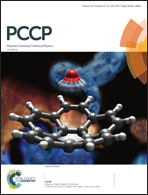Competition between stability of icosahedral and cuboctahedral morphologies in bimetallic nanoalloys†
Abstract
In this study, we investigated the heating process for pure (Rh55 and Cu55), single dopant (Rh1Cu54 and Rh54Cu), core@shell (Rh13@Cu42 and Cu13@Rh42), and alloy (Rh13Cu42, Rh42Cu13) nanoclusters in two structures (cuboctahedral and icosahedral) from 0 to 2000 K using molecular dynamics (MD) simulations. Our aim was to investigate the effects of composition and chemical arrangement on the kinetic and thermodynamic stability of Rh–Cu bimetallic nanoalloys. Our results indicated that Cu55, Ir55, Rh1Cu54, Rh54Cu, and Cu13@Rh42 in the cuboctahedral and icosahedral structures and Rh42Cu13 in the icosahedral structure did not experience any transformation with the exception of melting. It was also observed that the cuboctahedral Rh42Cu13 shows a solid–solid transformation to the icosahedral structure before the melting point. It is also observed that Rh13@Cu42 and Rh13Cu42 nanoclusters in both structures exhibit a transition to a pseudo-spherical structure before the melting point. Our results also illustrated that the Rh and Cu atoms tend to lie in the inner and outer shells of the nanoclusters, respectively. We have also discussed the changes in the melting points of the doped nanoclusters in the different arrangements.



 Please wait while we load your content...
Please wait while we load your content...